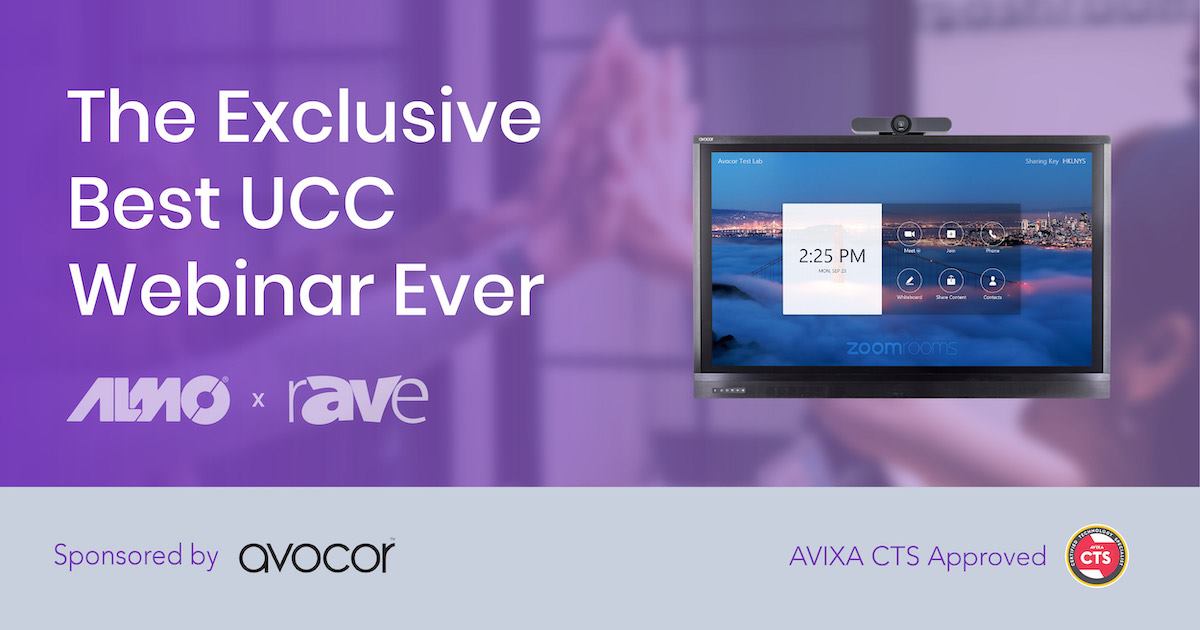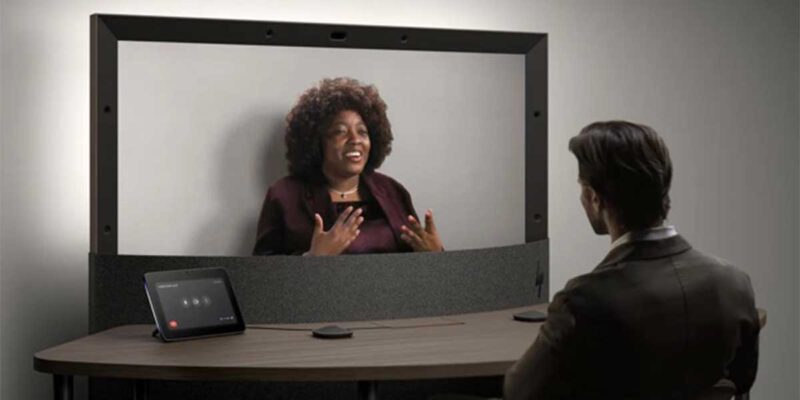The Exclusive Best UCC Blog Ever

I’m starting a trend of releasing a corresponding blog with my webinars, and this will be the second of that series. On Wednesday, I hosted a webinar in conjunction with Almo Pro A/V and Dana Corey of Avocor, in which I took you on a tour of the UCC world! But, in case you weren’t able to join, here’s the low-down.
What’s UCC?
It stands for unified communications and collaboration! But you probably knew that already, and that’s not what you’re here for. You’re here for the trends and how UCC is changing the industry and will continue to do so for years to come!
So, first of all, UCC can be a range of anything from collaboration display boards, fully integrated conference rooms, software, microphones, etc. These all work together to fall under the UCC umbrella. (By the way, if this interests you, we have an entire newsletter dedicated just to this corner of the market. Subscribe here!)
The Pieces
These are typically the things that make up a UCC space. Obviously, every space is different, or one solution can encompass multiple items, but you get the idea.
- Camera: Some cameras include microphone and speaker arrays in them, and some are just standalone cameras. The option you pick ultimately depends on what you’re using it for or the room’s needs. Sometimes you can utilize audio solutions that are preexisting in the conference room or huddle space!
- Microphone: There are also plenty of options out there for this. There are speaker bar options, tabletop options, and plenty of others. Again, the choice you end up with depends on what you’re looking for and the type of room you’re trying to equip.
- Room Scheduling Panel: This can range from an iPad on the wall to an integrated system panel. According to Dana, nearly all rooms he has managed have had a room scheduling option somewhere on/near the door. (People tend to like this because they don’t have to download an app on their phone and log in to see if the room is available. They can just check the panel by the meeting room door!)
- PC to Host Collaboration Client: This is an interesting one, notably because I wrote about this in my Krystal Ball article. I predict that eventually, we won’t need a PC. In fact, I predict Zoom will be able to integrate with a third-party device. I think Logitech will come out with a speaker bar with a camera and Zoom already built-in (and will allow companies like Avocor to build two levels of boards — one interactive meeting platform and one dedicated to collaboration outside of the meeting platform). But that’s neither here nor there. However, it does lead us to the question: What if you have a Zoom Room and want to host a Microsoft Teams meeting? That’s where BYOM comes in. I’ll get to that.
- UCC Video Collaboration Software: There are different types. One layer is simply video collaboration (like Zoom, BlueJeans, Webex), and the other layer is document collaboration (like Microsoft Teams). So, some people and companies use both Team and Zoom. There’s plenty of crossover.
- Unification Collaboration Software UX: This is a relatively new concept in which the room is not dedicated to Zoom and not dedicated to Teams, or any software for that matter. Instead, it has its own software interface (UC Workspace and T1V both make this). The person going into the room doesn’t have to log out or re-log in. It’s a single-touch entry point — the software has all the logos of the different collaboration software, and you select the one you want to use at that time. This is useful for companies who in the past have struggled with deciding which software option to go with. Now they don’t have to choose!
- Tabletop Power and Connectivity: Remember: Not everything is wireless. There are wireless connectivity options, but often this isn’t enough.
BYOM vs. RBM
I mentioned above that BYOMs are the new kids on the block of UCC. Here are what these two acronyms mean and the differences between the two.
- RBM = Room-based Meetings. This is what you likely already know; these are rooms with a dedicated platform (i.e., Zoom Rooms). These function by companies paying for a license for the room to be dedicated to this one software. You are primarily communicating with clients and other employees via this one platform or software — although there are (sometimes complicated) options to use a different software when you have to occasionally.
- BYOM = Bring-Your-Own-Meetings. Instead of having a room dedicated to one platform, this option allows you to bring your laptop/device into the meeting room and launch the meeting with the software of your choice (i.e. Barco ClickShare). You use whatever application(s) you have on your personal device — and wirelessly connect to the mic, speakers and camera in the conference room. Instead of figuring out how to use the room, you are using your own device and launching the application on your desktop. Some are pushing for more of these options because rather than paying for the client’s room license, you’re paying for the (less expensive) app license.
My Favorites
In every article I write and every webinar I host, I like to include my top picks. These are, in my opinion, products that stand out in the UCC market (in no particular order).
Collaboration Boards
- NEC — InfinityBoard. I like this because it has a lot of flexibility (not tied to specific software or app) and has options for different screen sizes, dual-screen side-by-side setups, camera positioning, etc.
- Avocor — Avocor is an excellent option because it gives the user a lot of options. Avocor is known for having a good, better and best board — so you can pick the board that best suits your individual needs.
- Sharp — The Sharp WCD is my other favorite. I even attended the launch! It has capabilities that allow it to stream in multiple locations at the same time, but it also has a great IoT sensor.
Cameras
- Logitech — Logitech makes cameras that work well for many different types of rooms at an affordable price, and it’s an option that many choose to go with.
- AVer — Has a wide variety of camera offerings that work for a variety of rooms and environments.
- Huddly — Has AI capabilities that allow for wide-angle viewing.
Mics
- Nureva — This company makes room-based mic systems (the HDL300 for bigger rooms and the HDL200 for smaller rooms). These products look like a speaker bar, and throw out virtual microphones all over the room, and they will pick up your voice.
- Ecler — These are individual conference mics and room-based mic systems.
- Stem Audio — This is a relatively new company with a great product that hasn’t even shipped yet. It’s a neat application if you’re looking to design a room and configure a system with the same software application.
Speakers
- ClearOne — This company is known for making a very popular ceiling speaker, and it’s one that many opt for in a conference room.
- Ecler — I wanted to point out this company again because it’s relatively new but has quietly taken the market by storm. I expect its products will only continue to get more popular as time goes on.
- JBL — This is another tried and true option. Everyone knows this company because it makes great speaker options for many different spaces.
Controllers
I don’t need to flesh out each of these, but you could potentially use any tablet as a control option for a room — but the below are options I would suggest looking into.
Room Scheduling
I explained this concept above, but these are the options I would suggest researching if you want to know more about preferred room scheduling options.
PC to Host Meetings
As explained above and explained in my Krystal Ball predictions, I see this as eventually going away. We at rAVe use Mac Minis to drive our meetings, but I think in the near future, you won’t need one. I’ll leave it at that.
UCC Collaboration Space
These are my favorite video collaboration software options. All are great, and I suggest doing research before deciding on which you want to go with because it all depends on what you’re looking for in collaboration software.
The only one I don’t personally like is Microsoft Teams. This is because if someone invites you to a Teams meeting, you have to set up an account first. Whereas, if someone invites me to a Zoom meeting, I don’t have to set up anything to join the meeting. (However, some prefer Teams because of its integrated workflow progression. Again, this is just my personal preference.)
Conclusion
As with most things, there isn’t a right or wrong when it comes to the UCC sphere. I touched on this multiple times — it really just comes down to your preferences and your expectations. During the original webinar, we took a poll and discovered 72% of you prefer BYOMs, so I think we can expect to see many more of those options soon.
For more information on any of the above, and to get Dana’s take on the subject and see us answer questions live — here is the recorded version of the webinar.




